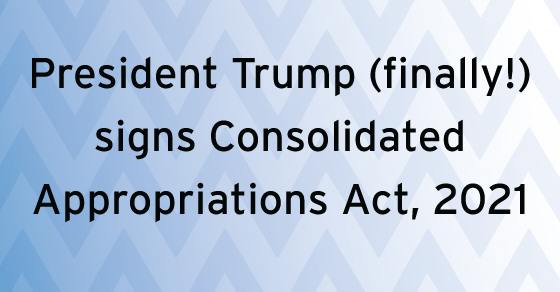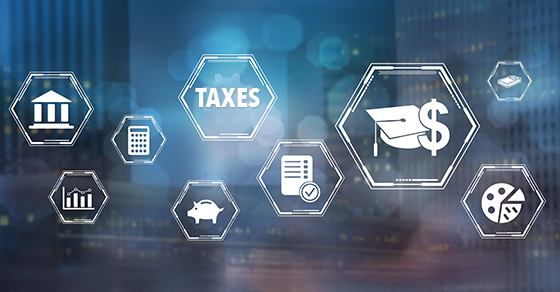Just before midnight on December 21, 2020, the Senate passed the Consolidated Appropriations Act of 2021 and sent it to President Trump for signature on December 22. After some political posturing, he finally signed the bill into law last night (December 27), some seven days later. His signing of this bill into law ends months of negotiations and political maneuvering to provide additional Covid-19 relief to American taxpayers. This has been a long time coming and of course in true Washington DC fashion, nothing ever gets done until the last minute. My commentary on the workings of the US government aside, let us look at what the legislation entails for your tax situation. NOTE- The new law also includes significant amounts of money for “behind the scenes” aid not specifically related to taxation.
The Consolidated Appropriations Act, 2021 is essentially two bills merged into one. It includes 900-billion-dollar Covid-19 Relief plus a 1.4 trillion-dollar resolution to fund the US government through September 2021. The total price tag is 2.3 trillion dollars and it only took Congress 5,600 pages of law to spend it. This provides the American taxpayers much needed relief as well as an operating government through September 2021.
BUSINESS PROVISIONS
Paycheck Protection Program (PPP 2.0)
PPP 2.0 is back with another round of $284 billion dollars in funding to provide these forgivable loans to both first time and second time small business borrowers. PPP 2.0 is available to those that previously received PPP loans as well as to those that have already applied for or received forgiveness of their original PPP loan.
The applicant certification present with the original PPP application that the “loan is necessary to support ongoing operations in light of the uncertainty of current economic conditions” remains in place and will have to be considered as of the application date for any new PPP 2.0 loan. This is a new certification and is based on current economic circumstances and not those existing at the time of the original PPP application.
However, PPP 2.0 does have some additional requirements for those looking to take a first (or second) bite at the PPP apple. PPP 2.0 is limited to businesses with less than 300 employees and must demonstrate a 25% drop in gross receipts in a 2020 quarter compared to the same quarter in 2019. We assume that the quarters will be calendar quarters (Jan-Mar, Apr-June etc.), but you can bet that SBA will be forthcoming with some additional “Interim Rules” to clarify and to provide guidance on required documentation.
This time around, Congress has included Sec 501(c) (6) entities such as business leagues and chambers of Congress. Unfortunately, the availability has only expanded to 501 (c)(6) exempt entities.
The maximum loan amount for PPP 2.0 is 2 million dollars which is reduced from the original PPP maximum loan amount of 10 million. While the calculation of an entity’s maximum loan amount is still based on the same 2.5 times average monthly payroll for most businesses, the food service industry is permitted to apply for a PPP loan based on 3.5 times average monthly payroll. This is in recognition of how hard our restaurants have been affected this year. These businesses with NAICS codes beginning with “72” are eligible for the higher loan amount. The NAICS code can be found on your tax return but you probably already know if you would qualify.
The legislation has also expanded the types of “qualifying expenses” able to be paid with PPP funds to include “covered property damage, supplier costs and worker protection expenditures”. We expect these expenses to be further defined but it appears they would include after insurance costs of damage caused by unrest (looting and vandalism) and could include expenses incurred like installation of plexiglass shields and other accommodations to allow for safer business operations. Covered worker protection expenditures could also include expenditures to air filtration system or creating a drive through window facility. It would also include payments for any business software or cloud computing services that facilitates business operations.
The bill also clarifies and codifies Congressional intent of the original PPP provisions in the CARES Act and states that businesses can deduct expenses paid for with PPP loan funds for tax purposes. This is true for both PPP and PPP 2.0 loans. There are no restrictions or limitations on the deductibility of these expenses. At one point during the negotiations, there was talk of including limitations on deductibility of PPP expenses, but those limitations thankfully are not in the final bill.
If you have been paying attention, this issue has been a thorny one for taxpayers/CPAs/Congress and the IRS. This provision in the bill specifically overrides the IRS position that expenses paid for with PPP funds would not be allowable tax deductions. Although this clarification took much longer than it should have, taxpayers should be happy that Congress got its way over the IRS. While this provision clarifies the federal treatment of PPP expense deductions, it is only a matter of time before the individual states start weighing in with their own treatment.
For those of you with PPP loans under $150,000 and have not yet filed your application for forgiveness, you might want to hold off. The law also provides a simplified application for loans under $150,000. Previously this simplified application was only available for PPP loans under $50,000. We expect that a new form will be released to accommodate the loans under $150,000 and will be like the process for the under $50,000 PPP loans. The law directs SBA to release the new forgiveness application form within 24 days of the enactment date.
And finally, the law includes set asides to support first or second time PPP borrowers with 10 or fewer employees to target smaller businesses for relief.
It is unknown how long it will take PPP lenders to get up and ready for PPP 2.0. We suggest that if you are interested in PPP 2.0 that you reach out to your bank for details on their plans and start laying the groundwork, so you are ready to go.
Economic Injury Disaster Loan (EIDL)
Additional money is made available to the Small Business Administration (SBA) to provide grants to businesses in low-income areas and additional money is available to certain other entities relying on live attendance such as live venues and independent movie theatres. These funds will be administered directly through SBA.
In addition, the legislation will also repeal the requirement that PPP borrowers deduct the amount of any EIDL advance from their PPP forgiveness amount.
Employee Retention Tax Credit (ERTC)
The Employee Retention Tax Credit (ERTC) is extended and expanded through July 1, 2021. The credit under the new law is increased from 50% of the first $10,000 in wages per employee for all calendar quarters, to 70% of the first $10,000 in wages per employee for ANY calendar quarter. This means that this credit could be worth up to $14,000 per employee (assuming $10,000 in qualified wages for both Q1 and Q2 of 2021). The law also reduces the threshold for gross receipt reduction for eligibility from 50% to 20%. These changes to the ERTC are effective for quarters beginning after 12/31/20.
The new law also allows PPP borrowers to take advantage of the ERTC (assuming all other ERTC requirements are met) retroactively to the original date of the CARES Act. So, for 2020 if you had a PPP loan and qualified for the ERTC, the credit is available for wages NOT paid for with PPP funds. Going forward into 2021, new PPP borrowers will be eligible for the expanded ERTC (assuming they meet ERTC eligibility requirements) referenced above.
Families First Coronavirus Relief Act Credits (FFCRA)
The law extends the availability of the employer credits for providing both sick leave and paid family and medical leave act through March 21, 2021. It appears that employers are no longer required to provide FFCRA sick leave as of January 1, 2021 but should they decide to these credits would be available.
Deduction for business meals
The Tax Cuts and Jobs Act of 2017 (TCJA) made numerous changes to the deductibility of business entertainment and business meal expenses. In fact, the IRS recently released a slew of new regulations addressing the changes made by TCJA. However, to help the struggling restaurant industry through this difficult time, the new law would allow a 100% deduction for qualified business meals for 2021 and 2020. The same requirements exist for deduction of business meals, the law just increases the deductible amount to 100% for the next two years.
INDIVIDUAL PROVISIONS
Relief Payments/Stimulus Checks
The amount of the direct relief payment to taxpayers was perhaps one of the more contentious (as to amount not existence) provisions included in the law. Lawmakers haggled over the amounts for months and finally settled on a payment of $600 per individual and qualified child with no cap on household size. Adult dependents are not eligible for the payment.
The stimulus checks would be processed like the first round of the Recovery Rebates through IRS and will be considered advanced tax credits based on 2019 income. Of course, there are always income threshold phaseouts. The rebate amounts begin to phase out at $75,000 for single filers, $112,500 for head of household filers and $150,000 for married filing jointly.
Extension of Unemployment Insurance Compensation Benefits
Although the extension of UI benefits is not specifically tax related, this is worth a mention as it may affect many folks. There is an 11-week extension of the UI benefits first provided by the CARES Act that are scheduled to expire on December 26, 2020. This will provide an additional $300 per week supplement to state UI compensation.
Pandemic Emergency Unemployment Compensation (PEUC) will also be extended to March 14, 2021. If you are currently unemployed you should check with your state UI department to see what benefits might be available to you under these extensions of benefits.
Child Tax Credit and Earned Income Tax Credit
Since many individuals that take advantage of these credits may have experienced a job loss or a reduction in wages during 2020, the new law allows the calculation for these credits to be based on 2019 income to determine eligibility.
Above the Line Charitable Contribution Deduction
For 2020, individuals can deduct up to $300 in cash contributions to a qualified charity. This is an above the line deduction so even if you are not able to itemize, you get the deduction. The new law increases this amount for 2021 to $600.
In addition to the new items provided for in the new law, it also extends the “Extenders”. “Extenders” are generally the provisions that Congress must renew annually or every other year. Some years they extend provisions retroactively. The “extender bill” is usually the one we are waiting for before they leave for Christmas break. There are many “Extenders” included in the law, however I will only mention a few of the more relevant items in brief—
– The new law makes permanent (or as permanent Congress can be) the reduced threshold for claiming medical expense deductions of 7.5%. This was scheduled to move to 10% in 2021.
– Coordination of phaseout rules in connection with American Opportunity Tax Credits and Lifetime Learning Credits for education. This makes the phaseout rules the same for both credits. This is effective for 2021 and in addition, the new law repeals the Higher Education Expense Deduction for 2021.
– Work Opportunity Credit has extended the credit through 2025. It was scheduled to sunset for 2021.
– Exclusion from Gross Income Discharge of Qualified Principal Residence Indebtedness and Reduction in Maximum Indebtedness Limits. Under old law prior to 1/1/2021, discharge of indebtedness up to $2 million ($1 million for married filing separately) was excluded from gross income. The new law extends the exclusion through 2025 and reduced the allowable excluded amount to $750,000 ($375,000 for married filing separately).
This letter contains numerous new provisions as well as the extension of some of the older ones. As with any legislation thrown together in a relatively short amount of time, there are bound to be things Congress did not consider or areas that more guidance will be needed. This represents our current understanding of the Consolidated Appropriations Act of 2021.
We anticipate that the new Biden administration will continue providing relief to the American taxpayer and address things removed from the current bill so that it could pass Congress.
While we may not have all the answers since the ink is barely dry on the law, please contact your Maillie representative if you have any questions. On behalf of everyone here at Maillie, we wish you the happiest of Holiday Seasons!





